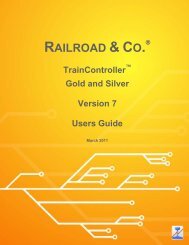Download - Freiwald Software
Download - Freiwald Software
Download - Freiwald Software
You also want an ePaper? Increase the reach of your titles
YUMPU automatically turns print PDFs into web optimized ePapers that Google loves.
!<br />
In the diagram displayed above the smart mode is shown. On entry into block “Main<br />
Line East” the Dispatcher does not only reserve block “Southtown 2” at the bottom.<br />
The Dispatcher also checks, whether there is a route directly behind “Southtown 2”.<br />
Since this is the case, this route and the block behind of this route are reserved, too.<br />
This is done to avoid unintentional train stops in “Southtown 2” due to the fact, that the<br />
train must not leave “Southtown 2” before the route to “Main Line West” is activated.<br />
If “Southtown 2” and “Main Line West” were connected by a link that does not contain<br />
a route, then only “Southtown 2” would be reserved in this moment.<br />
Smart reservation helps to avoid unintentional train stops caused by long lasting<br />
route activation.<br />
What happens, if “Main Line West” is currently not available in this situation? This is<br />
no problem. The Dispatcher only tries to reserve the additional route and the block behind<br />
of “Southtown 2”. If this is currently not possible, then the train is allowed to proceed<br />
at least to “Southtown 2”, though.<br />
It is also possible to instruct the Dispatcher not to apply the smart mode to a certain<br />
schedule. In this case it is possible to specify a fixed number of blocks, that the Dispatcher<br />
shall try to reserve during execution of the related schedule. If, for example, the<br />
number of blocks to be reserved ahead is set to 2, then the Dispatcher will always try to<br />
maintain the next 2 blocks in front of the train reserved for this train. If it is not possible<br />
to reserve the specified number, then the Dispatcher will allow the train to proceed,<br />
though, if at least one block in front of the train is available.<br />
Using a fixed number of 2 as look ahead for the block reservation ensures that the distant<br />
signal, which is assigned to the block ahead, always shows a correct state. If it is<br />
desired to install a signaling system, that is based on the internally calculated signal aspects<br />
of the Dispatcher, then this option might be useful, especially if distant signals<br />
should be taken into account.<br />
By increasing the look ahead any further for certain schedules it is additionally possible<br />
to give certain trains a higher priority. When a train is able to reserve the complete path<br />
to the destination during start of the schedule, then it is sure, that it cannot be blocked<br />
by concurrent trains during its journey. It has received a high priority to reach its<br />
destination.<br />
140










